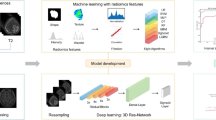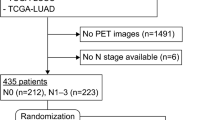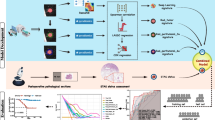Abstract
Objective
We developed a deep learning model for distinguishing radiation therapy (RT)-related changes and tumour recurrence in patients with lung cancer who underwent RT, and evaluated its performance.
Methods
We retrospectively recruited 308 patients with lung cancer with RT-related changes observed on 18F-fluorodeoxyglucose positron emission tomography–computed tomography (18F-FDG PET/CT) performed after RT. Patients were labelled as positive or negative for tumour recurrence through histologic diagnosis or clinical follow-up after 18F-FDG PET/CT. A two-dimensional (2D) slice-based convolutional neural network (CNN) model was created with a total of 3329 slices as input, and performance was evaluated with five independent test sets.
Results
For the five independent test sets, the area under the curve (AUC) of the receiver operating characteristic curve, sensitivity, and specificity were in the range of 0.98–0.99, 95–98%, and 87–95%, respectively. The region determined by the model was confirmed as an actual recurred tumour through the explainable artificial intelligence (AI) using gradient-weighted class activation mapping (Grad-CAM).
Conclusion
The 2D slice-based CNN model using 18F-FDG PET imaging was able to distinguish well between RT-related changes and tumour recurrence in patients with lung cancer.





Similar content being viewed by others
Data availability
Data generated or analysed during the study are available from the corresponding author upon reasonable request.
References
Detterbeck FC, Boffa DJ, Kim AW, Tanoue LT. The eighth edition lung cancer stage classification. Chest.2017;151:193–203
Ries L, Melbert D, Krapcho M, Stinchcomb D, Howlader N, Horner M, et al. SEER cancer statistics review, 1975–2005. Bethesda, MD: National Cancer Institute. 2008;2999.
Wood DE, Kazerooni EA, Aberle D, Berman A, Brown LM, Eapen GA, et al. NCCN guidelines® insights: lung cancer screening, version 12022: featured updates to the NCCN guidelines. J Natl Comprehen Cancer Netw. 2022;20:754–64.
Veenstra CM, Vachani A, Ciunci CA, Zafar HM, Epstein AJ, Paulson EC. Trends in the use of 18F-fluorodeoxyglucose PET imaging in surveillance of non-small-cell lung and colorectal cancer. J Am Coll Radiol. 2016;13:491–6.
Choi H. Deep learning in nuclear medicine and molecular imaging: current perspectives and future directions. Nucl Med Mol Imaging. 2018;52:109–18.
Decuyper M, Maebe J, Van Holen R, Vandenberghe S. Artificial intelligence with deep learning in nuclear medicine and radiology. EJNMMI Phys. 2021;8:81.
Han S, Oh JS, Lee JJ. Diagnostic performance of deep learning models for detecting bone metastasis on whole-body bone scan in prostate cancer. Eur J Nucl Med Mol Imaging. 2022;49:585–95.
Lee JJ, Yang H, Franc BL, Iagaru A, Davidzon GA. Deep learning detection of prostate cancer recurrence with 18F-FACBC (fluciclovine, Axumin®) positron emission tomography. Eur J Nucl Med Mol Imaging. 2020;47:2992–7.
Selvaraju RR, Cogswell M, Das A, Vedantam R, Parikh D, Batra D. Grad-CAM: visual explanations from deep networks via gradient-based localization. Int J Comput Vision. 2020;128:336–59.
Benveniste MF, Gomez D, Carter BW, Cuellar SLB, Shroff GS, Benveniste APA, et al. Recognizing radiation therapy–related complications in the chest. Radiographics. 2019;39:344–66.
Osman AM, Korashi HI. PET/CT implication on bronchogenic carcinoma TNM staging and follow-up using RECIST/PERCIST criteria: a comparative study with CT. Egypt J Radiol Nuclear Med. 2020;51:1–12.
Jiménez-Bonilla JF, Quirce R, Martínez-Rodríguez I, Banzo I, Rubio-Vassallo AS, Del Castillo-Matos R, et al. Diagnosis of recurrence and assessment of post-recurrence survival in patients with extracranial non-small cell lung cancer evaluated by 18F-FDG PET/CT. Lung Cancer. 2013;81:71–6.
Suga M, Nishii R, Miwa K, Kamitaka Y, Yamazaki K, Tamura K, et al. Differentiation between non-small cell lung cancer and radiation pneumonitis after carbon-ion radiotherapy by 18F-FDG PET/CT texture analysis. Sci Rep. 2021;11:11509.
Park YW, Choi D, Park JE, Ahn SS, Kim H, Chang JH, et al. Differentiation of recurrent glioblastoma from radiation necrosis using diffusion radiomics with machine learning model development and external validation. Sci Rep. 2021;11:2913.
Han K, Joung JF, Han M, Sung W, Kang Y-N. Locoregional recurrence prediction using a deep neural network of radiological and radiotherapy images. J Personal Med. 2022;12:143.
Kim I, Rajaraman S, Antani S. Visual interpretation of convolutional neural network predictions in classifying medical image modalities. Diagnostics. 2019;9:38.
Panwar H, Gupta PK, Siddiqui MK, Morales-Menendez R, Bhardwaj P, Singh V. A deep learning and grad-CAM based color visualization approach for fast detection of COVID-19 cases using chest X-ray and CT-scan images. Chaos Solitons Fractals. 2020;140:110190.
Yang C, Rangarajan A, Ranka S. Visual explanations from deep 3D convolutional neural networks for Alzheimer’s disease classification. AMIA Annu Symp Proc. 2018;2018:1571–80.
Funding
This work was supported by the National Research Foundation of Korea (NRF) grant funded by the Korean government (Ministry of Science and ICT; No. NRF-2020M2D9A1094074; 2021R1A2C3009056) and by a grant from the Korea Health Technology R&D Project through the Korea Health Industry Development Institute (KHIDI), funded by the Ministry of Health & Welfare, Republic of Korea (HI18C2383).
Author information
Authors and Affiliations
Contributions
Changhwan Sung, Jungsu S. Oh, and Jong Jin Lee contributed to the study conceptualization, data acquisition, data analysis, data interpretation, writing, and editing of the manuscript. Byung Soo Park contributed to data analysis and writing of the manuscript. Su Ssan Kim and Si Yeol Song contributed to the study conceptualization, data interpretation, and editing of the manuscript.
Corresponding author
Ethics declarations
Conflict of interest
The authors declare no conflict of interest.
Ethical approval
All procedures performed in studies involving human participants were in accordance with the ethical standards of the institutional and/or national research committee and the principles of the 1964 Declaration of Helsinki and its subsequent amendments or comparable ethical standards.
Informed consent
This retrospective study was approved by the local Institutional Review Board (IRB No. 2022-1078). The need for informed consent was waived by the committee.
Additional information
Publisher's Note
Springer Nature remains neutral with regard to jurisdictional claims in published maps and institutional affiliations.
Supplementary Information
Below is the link to the electronic supplementary material.
12149_2024_1925_MOESM1_ESM.pptx
Supplementary Figure 1. Representative images where both the 18F-FDG PET/CT formal report and the deep learning model were false negative. A 67-year-old woman diagnosed with squamous cell carcinoma in the apex of the right lung. (a) On the 18F-FDG PET/CT imaging performed three months after the completion of CCRT, a nodular and ground glass opacity (GGO) lesion with mildly hypermetabolic activity was observed at the apex of the right lung. Both the formal report and the deep learning model predicted this lesion as an RT-related change. (b) On the follow-up 18F-FDG PET/CT imaging after four months, the lesion progressed, with an increase of SUVmax from 3.7 to 8.0. Although no additional pathological confirmation was performed, the patient exhibited rapid progression and died four months later. Supplementary file1 (PPTX 1219 KB)
Rights and permissions
Springer Nature or its licensor (e.g. a society or other partner) holds exclusive rights to this article under a publishing agreement with the author(s) or other rightsholder(s); author self-archiving of the accepted manuscript version of this article is solely governed by the terms of such publishing agreement and applicable law.
About this article
Cite this article
Sung, C., Oh, J.S., Park, B.S. et al. Diagnostic performance of a deep-learning model using 18F-FDG PET/CT for evaluating recurrence after radiation therapy in patients with lung cancer. Ann Nucl Med (2024). https://doi.org/10.1007/s12149-024-01925-5
Received:
Accepted:
Published:
DOI: https://doi.org/10.1007/s12149-024-01925-5




